yeovil at War
James Henry Crouch
Killed in action on the Western Front
James Henry Crouch was born on 31 May 1883 at 75 Paradise Row, Huish, the eldest son of mason's labourer George Crouch (1855-1933), originally from Stoford, and Mary Ann née Parsons, known as Ann, (1847-1920) of Stratton, Dorset. James was one of seven children; Kate Madora Mary (1879-1943), Ada Florence (1881-1881), Mary Jane (b1882), Jessie Ann (1882-1895), James, Rosa, known as Bessie (1886-1931) and George Stephen, known as Stephen (1890-1893) - all born in Yeovil. In the 1891 census George and Ann were living in Huish with their children; Kate, Jessie, Mary, James, Bessie and Stephen.
By 1901 the family had moved to London and were listed in the 1901 census living at 7 Bravington Road, Paddington although only George, Mary, James and Rosa were living there. George was now working as a labourer in a coal yard.
In early 1905 James married Jane Blanche Beck, known as Jenny (1886-1967) at Paddington. They were to have five children; Florence Jenny Rose, known as Florrie (1906-1991), James (1907-1907), Henry James, known as Harry (1909-1984), George (1911-1993) and Gertrude M (b1913).
James and Jenny moved back to Yeovil between 1906 and 1909 and initially living at 52 South Street, where they were recorded in the 1911 census with Florrie and Harry. James worked at Aplin & Barrett's factory as a night watchman and Jenny sewed glove linings. They later moved to 14 Gladstone Terrace, St Michael's Avenue.
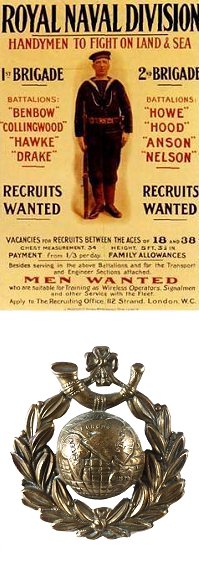 James
enlisted in the
Royal Marine
Light Infantry,
1st Royal Marine
Battalion, Royal
Naval Division
on 9 February
1917. His
Service Number
was PO/1781/S.
James
enlisted in the
Royal Marine
Light Infantry,
1st Royal Marine
Battalion, Royal
Naval Division
on 9 February
1917. His
Service Number
was PO/1781/S.
He was in the draft for the British Expeditionary Force with his battalion on 27 March 1917.
The first major action in which James was involved was the Second Battle of the Scarpe (23-24 April 1917), a phase of the Arras Offensive.
At 04:45 on 23 April, following two days of poor visibility and freezing weather, British troops of the Third Army attacked to the east along a nine mile (14 km) front from Croisilles to Gavrelle on both sides of the Scarpe. On the left of the main British attack the 63rd Division, including James, made rapid progress against Gavrelle and secured the village. Several determined German counter-attacks were made and by the morning of 24 April, the British held Guémappe, Gavrelle and the high ground overlooking Fontaine-lez-Croisilles and Cherisy.
The next action in which James' battalion took part was the next phase of the Arras Offensive, known as the Battle of Arleux (28 to 29 April 1917). Although the Canadian Corps had taken Vimy Ridge, difficulties in securing the south-eastern flank had left the position vulnerable. To rectify this, British and Canadian troops launched an attack towards Arleux-en-Gohelle on 28 April. Arleux was captured by Canadian troops with relative ease, but the British troops advancing on Gavrelle met stiffer resistance from the Germans. The village was secured by early evening but, despite achieving the limited objective of securing the Canadian position on Vimy Ridge, casualties were high, and the ultimate result was disappointing.
There followed a period of relative inactivity for the battalion until it took part in the Second Battle of Passchendaele (26 October – 10 November 1917), a phase of the Third Battle of Ypres. The battle took place in the Ypres Salient area of the Western Front, in and around the Belgian town of Passchendaele. It was also involved in the action of Welsh Ridge on 30 December 1917, an action subsequent to the Cambrai operations.
In 1918 they were in action in the Battle of St Quentin (21-23 March 1918) and the First Battle of Bapaume (24-25 March 1918), both were phases of the First Battles of the Somme 1918
The Battle of St Quentin began the German's Spring Offensive on 21 March 1918. It was launched from the Hindenburg Line, in the vicinity of Saint-Quentin, France. Its goal was to break through the Allied lines and advance in a north-westerly direction to seize the Channel ports, which supplied the British Expeditionary Force (BEF) and to drive the BEF into the sea. Two days later General Ludendorff, the Chief of the German General Staff, changed his plan and pushed for an offensive due west, along the whole of the British front north of the River Somme. This was designed to separate the French and British Armies and crush the British forces by pushing them into the sea. The offensive ended at Villers-Bretonneux, to the east of the Allied communications centre at Amiens, where the Allies managed to halt the German advance; the German Armies had suffered many casualties and were unable to maintain supplies to the advancing troops. Much of the ground fought over was the wilderness left by the Battle of the Somme in 1916. The action was therefore officially named by the British Battles Nomenclature Committee as The First Battles of the Somme, 1918.
The following day the battalion was involved in the First Battle of Bapaume. In the late evening of 24 March, after enduring unceasing shelling, Bapaume was evacuated and then occupied by German forces on the following day. After three days the infantry was exhausted and the advance bogged down, as it became increasingly difficult to move artillery and supplies over the Somme battlefield of 1916 and the wasteland of the 1917 German retreat to the Hindenburg Line. On 25th the troops were ordered to withdraw and reorganise.
Following these actions the 1st Royal Marine Battalion settled into the day to day fighting of the Western Front. During this period James was batman to the Regimental Sergeant-Major and during the night of 31 May 1918, while they were asleep, both men were killed by a shell. It was James' 34th birthday.
On 28 June 1918 the Western Gazette reported "Mrs JH Crouch, of 14 Gladstone Terrace, St. Michael’s Avenue, has received notification from the Record Office, Royal Naval Division, that her husband, Private James Henry Crouch of the - Royal Marine Battalion, was killed in action on May 31st. Lieutenant F Dean, writing to the bereaved widow states that Private Crouch was instantly killed by a shell on the night of May 31st whilst asleep. He was batman to the sergeant-major, who was also killed at the same time. The Commanding Officer and all ranks joined in sending their sympathy. “Your husband did good work out here,” he concludes, “and died a soldier’s death alongside his master, whom he served faithfully.” - The late Private Crouch was the only (sic) son of Mr and Mrs G Crouch, who formerly lived in Paradise Row, Huish, but now reside in London. He was formerly employed at Messrs. Aplin & Barrett’s and it is a pathetic coincidence that he was killed on his 34th birthday. He leaves a widow and four children aged 12, 9, 7 and 5."
James was interred in Forceville Communal Cemetery and Extension Plot 4. Row D. Grave 9, Somme, France. His name is recorded on the Yeovil War Memorial in the Borough.
gallery
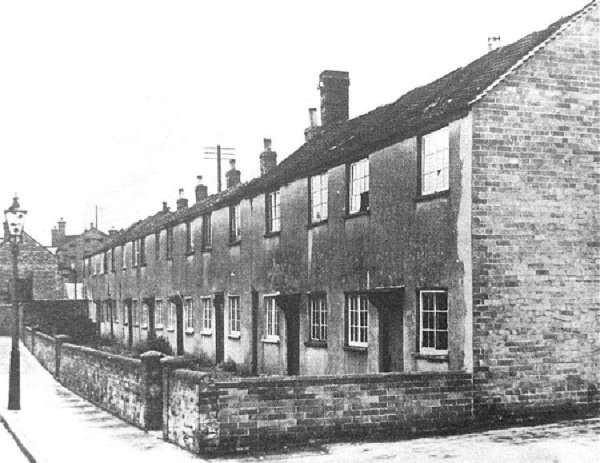
Paradise Row photographed about 1910. James was born here on 31 May 1883.
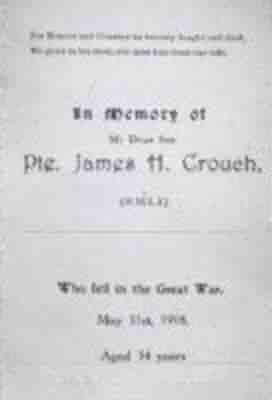
Courtesy of Phil
Maxim
A memorial card to James Crouch.
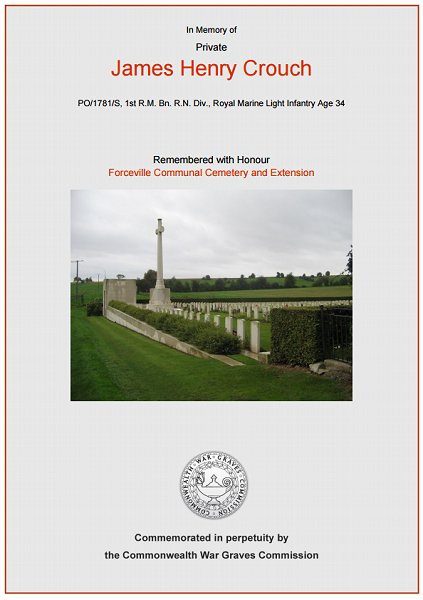
The Commonwealth War Graves Commission certificate in memory of James Crouch./p>
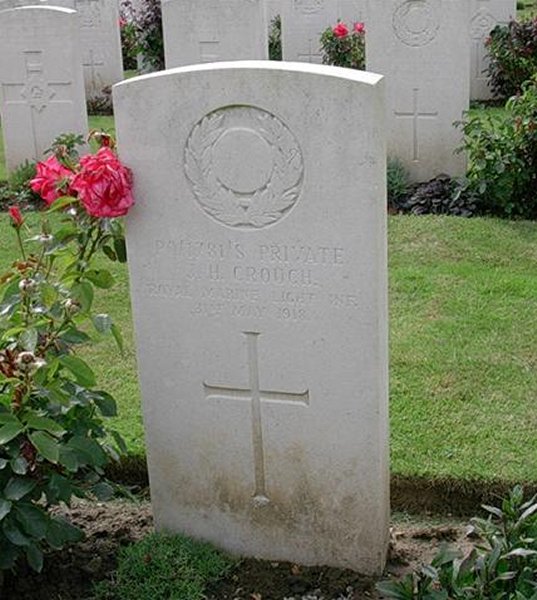
James Crouch's CWGC headstone.